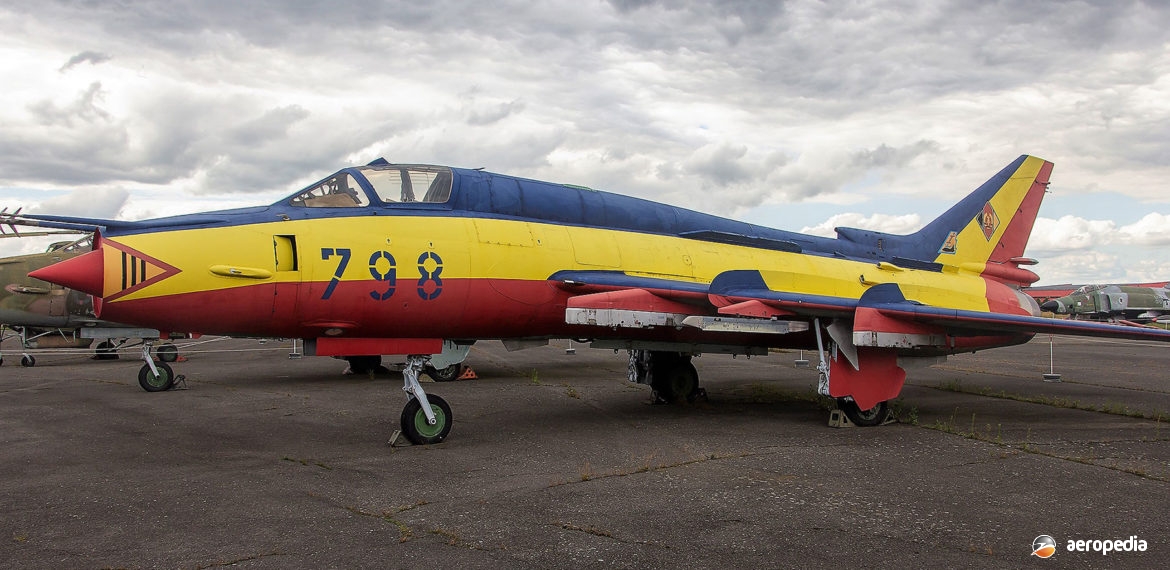Photograph:
Sukhoi Su-22M4 serial 798 of the former East German Air Force on display at Gatow, in August 2013 (Steven Veigel)
Country of origin:
Union of Soviet Socialist Republics
Description:
Single-seat attack aircraft
Power Plant:
(SU-22M4)
One 17,200 lbst, 24,700 lbst with afterburner, Lyulka AL-21F-3 turbojet
Specifications:
- Wingspan: 13.68 m (44 ft 10 in)
- Length: 19.02 m (26 ft 5 in)
- Height: 4.89 m (16 ft 5 in)
- Max speed at sea level: 1,400 km/h (870 mph)
- Max speed at altitude: 1,860 km/h 1,155 mph) – Mach 1.74
- Max operating height: 14,200 m (46,585 ft)
- Combat range with 2,000 kg (4,410 lb) war load: 1,150 km (715 miles)
- Ferry range: 2,300 km (1,430 miles)
- Take-off run at max all up weight: 900 m (2,944 ft)
- Landing roll with drag chute: 950 m (3,120 ft)
- Fuel capacity: 3,770 kg (8,310 lb)
- Empty weight: 10,767 kg (23,736 lb)
- Loaded weight: 19,430 kg (42,835 lb)
Armament:
Two 30 mm Nudelman-Rikhter NR-30 cannon; two launch rails for AA-8 Aphid air-to-air missiles; up to 4,000 kg (8,820 lb) of ordinance on ten hardpoints including free fall bombs, rocket pods, cluster bombs, cannon pods, ECM pods, napalm tanks and nuclear weapons
History:
The Su-22 was a development of the Su-17, and before that the Su-7, attack aircraft developed for the Russian Air Force and was built in large numbers, seeing service throughout the eastern bloc, and with Middle East air forces, including Libya, Iraq, and Yemen, as well as with the Peru Air Force in South America. The Sukhoi OKB designed a high-speed, medium-range, low-level ground attack and reconnaissance aircraft. It was a variable-geometry swing-wing aircraft and in the Su-22 form was the most modern and powerful Warsaw Pact fighter-bomber of its time. It was simple and robust, and was intended to have trouble free use under the most demanding operating and environmental conditions, this being combined with ease of maintenance.
Powerplant was the proven Lyulka AL-21F-3 engine. In Russia it was used by both the Russian Air Force and Russian Naval Aviation. Some, after retirement, went to third-world countries such as Angola, Turkmenistan, Uzbekistan etc. A total of 145 was supplied to the Vietnam People’s Air Force, 60 to Syria, 70 to Afghan Air Force, Algeria, Azerbaijan, Belaruse, Bulgaria, Czech Republic, Egypt etc.
The Su-22M4 was the export variant and was supplied to a number of countries, being comparable to the Panavia Tornado GR.1 but did not have that aircraft’s all-weather capability. It had a laser range finder designator and terrain following radar. It could be fitted with bombs, guided missiles and rockets. Two 30 mm cannon could be installed for surface attack. In the air-to-air role it could be fitted with guided missiles and had an extensive ECM and chaff/flare system.
At least one example has been operated in the west as a civil aircraft for airshow work, having been obtained from the former East German Air Force, being operated by Hawker Hunter Aviation from RAF Scampton. Others are known to have been obtained by the United States for testing purposes.
The forward fuselage of an Su-22M4 Fitter K was obtained by Paul Cunningham in Victoria for display purposes, this aircraft being c/n 24603 serial 4603. It was built in about 2008 and served with Units 6 PLMB, 40 PLMB, 39 ELT and 8 ELT of the Polish Air Force until retired in 2008 and partly broken up, the fuselage section being imported to Australia in 2010 where it has been mounted on a trailer and is shown at various aviation events around Victoria.

